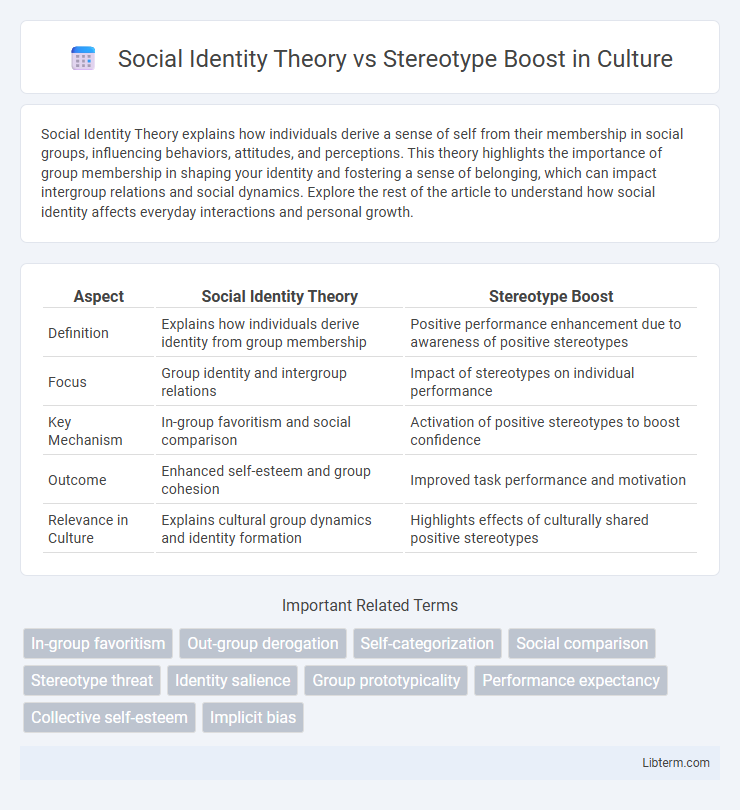Social Identity Theory explains how individuals derive a sense of self from their membership in social groups, influencing behaviors, attitudes, and perceptions. This theory highlights the importance of group membership in shaping your identity and fostering a sense of belonging, which can impact intergroup relations and social dynamics. Explore the rest of the article to understand how social identity affects everyday interactions and personal growth.
Table of Comparison
| Aspect | Social Identity Theory | Stereotype Boost |
|---|---|---|
| Definition | Explains how individuals derive identity from group membership | Positive performance enhancement due to awareness of positive stereotypes |
| Focus | Group identity and intergroup relations | Impact of stereotypes on individual performance |
| Key Mechanism | In-group favoritism and social comparison | Activation of positive stereotypes to boost confidence |
| Outcome | Enhanced self-esteem and group cohesion | Improved task performance and motivation |
| Relevance in Culture | Explains cultural group dynamics and identity formation | Highlights effects of culturally shared positive stereotypes |
Introduction to Social Identity Theory
Social Identity Theory explains how individuals derive a sense of self from their group memberships, emphasizing the importance of social categorization, social identification, and social comparison. This theory highlights how group affiliation influences self-esteem and behavior, often leading to in-group favoritism and out-group discrimination. Understanding Social Identity Theory provides a framework for analyzing intergroup relations and the psychological mechanisms behind social biases.
Defining Stereotype Boost
Stereotype Boost refers to the phenomenon where positive stereotypes about a social group enhance individuals' performance in relevant tasks by increasing confidence and motivation. Unlike Social Identity Theory, which emphasizes group membership and emotional significance influencing behavior and self-concept, Stereotype Boost specifically highlights the performance improvement linked to activation of positive group-based expectancies. Research demonstrates that positive stereotypes can lead to measurable gains in academic and cognitive outcomes by reinforcing a sense of competence associated with one's social identity.
Historical Development and Origins
Social Identity Theory, developed by Henri Tajfel in the 1970s, explains group behavior by emphasizing individuals' identification with social groups and the resulting in-group favoritism and out-group discrimination. Stereotype Boost emerged from research in the early 2000s, highlighting how positive stereotypes can enhance performance and confidence in stereotype-relevant tasks. While Social Identity Theory has roots in social psychology studying intergroup relations, Stereotype Boost originated from cognitive and performance psychology investigating the impact of societal beliefs on individual behavior.
Key Concepts in Social Identity Theory
Social Identity Theory emphasizes the significance of group membership in shaping individual self-concept and behavior. Key concepts include social categorization, which divides people into in-groups and out-groups; social identification, where individuals adopt the identity of their group; and social comparison, leading to in-group favoritism and enhancing self-esteem. These dynamics influence intergroup behavior and underpin phenomena like stereotype boost, where positive stereotypes improve performance for members of a stigmatized group.
Mechanisms Behind Stereotype Boost
Stereotype Boost occurs when individuals perform better due to positive stereotypes linked to their social group, driven by increased confidence and expectancy effects. Mechanisms behind stereotype boost include enhanced self-efficacy, reduced anxiety, and motivational arousal triggered by awareness of advantageous group stereotypes. Social Identity Theory explains group behavior by emphasizing identity salience and social categorization but contrasts with stereotype boost by focusing on in-group favoritism and bias rather than performance enhancement mechanisms.
Group Dynamics and Individual Behavior
Social Identity Theory explains how individuals derive a sense of self from group membership, influencing attitudes and behaviors to favor in-group cohesion and differentiation from out-groups. Stereotype Boost refers to the enhanced performance individuals exhibit when positive group stereotypes are activated, highlighting the interplay between group identity and individual capabilities. These phenomena underscore the dynamic relationship between group dynamics and individual behavior, where social context shapes personal outcomes.
Psychological Impacts on Performance
Social Identity Theory explains how an individual's awareness of group membership influences self-concept and motivation, often affecting performance through in-group favoritism or out-group discrimination. Stereotype Boost occurs when positive stereotypes about a group enhance an individual's confidence and task performance, contrasting with stereotype threat, which impairs it. Both concepts significantly impact psychological states such as anxiety, self-efficacy, and motivation, leading to measurable variations in cognitive and physical task outcomes.
Empirical Evidence and Research Findings
Empirical evidence demonstrates that Social Identity Theory explains intergroup behavior through the categorization, identification, and comparison processes impacting self-esteem and group dynamics. Research findings reveal that stereotype boost occurs when positive stereotypes enhance performance, as seen in studies where Asian Americans outperform due to culturally ingrained expectations. Experimental data supports the differentiation between these phenomena by showing how Social Identity Theory underpins group bias, whereas stereotype boost specifically influences individual cognitive outcomes tied to prevailing group stereotypes.
Implications in Education and Workplaces
Social Identity Theory explains how individuals derive self-concept from group membership, influencing behavior and attitudes in educational and workplace settings. Stereotype Boost refers to enhanced performance when positive stereotypes about one's group are activated, affecting motivation and achievement. Understanding these dynamics helps educators and employers design interventions that promote inclusivity, reduce bias, and leverage positive group identities to improve outcomes.
Future Directions and Practical Applications
Future research on Social Identity Theory (SIT) and stereotype boost should explore neural mechanisms underlying group-based performance enhancement to better tailor interventions in educational and organizational settings. Practical applications may include developing targeted training programs that leverage positive stereotypes to improve motivation and outcomes for underrepresented groups. Integrating SIT with stereotype boost insights can inform policies promoting inclusive environments that harness group identity for enhanced cognitive and social performance.
Social Identity Theory Infographic

 libterm.com
libterm.com